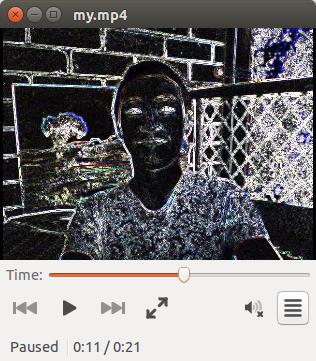[OpenCV] Samples 12: laplace
Posted 机器学习水很深
tags:
篇首语:本文由小常识网(cha138.com)小编为大家整理,主要介绍了[OpenCV] Samples 12: laplace相关的知识,希望对你有一定的参考价值。
先模糊再laplace,也可以替换为sobel等。
变换效果后录成视频,挺好玩。

#include "opencv2/videoio/videoio.hpp" #include "opencv2/highgui/highgui.hpp" #include "opencv2/imgproc/imgproc.hpp" #include <opencv2/core/utility.hpp> #include <ctype.h> #include <stdio.h> #include <iostream> using namespace cv; using namespace std; static void help() { cout << "\\nThis program demonstrates Laplace point/edge detection using OpenCV function Laplacian()\\n" "It captures from the camera of your choice: 0, 1, ... default 0\\n" "Call:\\n" "./laplace -c=<camera #, default 0> -p=<index of the frame to be decoded/captured next>\\n" << endl; } enum {GAUSSIAN, BLUR, MEDIAN}; int sigma = 3; int smoothType = GAUSSIAN; int main( int argc, char** argv ) { VideoCapture cap; cv::CommandLineParser parser(argc, argv, "{help h | | }{ c | 0 | }{ p | | }"); if ( parser.has("help") ) { help(); return 0; } if( parser.get<string>("c").size() == 1 && isdigit(parser.get<string>("c")[0]) ) { cout << "debug 1:" << parser.get<int>("c") << endl; cap.open(parser.get<int>("c")); } else { cout << "debug 2:" << parser.get<string>("c") << endl; cap.open(parser.get<string>("c")); } if( cap.isOpened() ) cout << "Video " << parser.get<string>("c") << ": width=" << cap.get(CAP_PROP_FRAME_WIDTH) << ", height=" << cap.get(CAP_PROP_FRAME_HEIGHT) << ", nframes=" << cap.get(CAP_PROP_FRAME_COUNT) << endl; // Jeff --> "nframes == -1" // try to return more frames? if( parser.has("p") ) { int pos = parser.get<int>("p"); if (!parser.check()) { parser.printErrors(); return -1; } cout << "seeking to frame #" << pos << endl; cap.set(CAP_PROP_POS_FRAMES, pos); } if( !cap.isOpened() ) { cout << "Could not initialize capturing...\\n"; return -1; } namedWindow( "Laplacian", 0 ); createTrackbar( "Sigma", "Laplacian", &sigma, 15, 0 ); CvSize size1 = cvSize( (int)cap.get(CAP_PROP_FRAME_WIDTH), (int)cap.get(CAP_PROP_FRAME_HEIGHT)); CvVideoWriter* wrVideo1 = cvCreateVideoWriter("./my.mp4", CV_FOURCC(\'P\',\'I\',\'M\',\'1\'), 32, size1); // CV_FOURCC: // CV_FOURCC(\'P\',\'I\',\'M\',\'1\') MPEG-1 codec // CV_FOURCC(\'M\',\'J\',\'P\',\'G\') motion-jpeg codec (does not work well) // CV_FOURCC(\'M\', \'P\', \'4\', \'2\') MPEG-4.2 codec // CV_FOURCC(\'D\', \'I\', \'V\', \'3\') MPEG-4.3 codec // CV_FOURCC(\'D\', \'I\', \'V\', \'X\') MPEG-4 codec // CV_FOURCC(\'U\', \'2\', \'6\', \'3\') H263 codec // CV_FOURCC(\'I\', \'2\', \'6\', \'3\') H263I codec // CV_FOURCC(\'F\', \'L\', \'V\', \'1\') FLV1 codec Mat smoothed, laplace, result; for(;;) { Mat frame; cap >> frame; if( frame.empty() ) break; /* * Step 1: 高斯,均值, 中值 */ int ksize = (sigma*5)|1; if(smoothType == GAUSSIAN) GaussianBlur(frame, smoothed, Size(ksize, ksize), sigma, sigma); else if(smoothType == BLUR) blur(frame, smoothed, Size(ksize, ksize)); else medianBlur(frame, smoothed, ksize); /* * Step 2: extract edges. * In: smoothed. * Out: laplace. */ Laplacian(smoothed, laplace, CV_16S, 5); convertScaleAbs(laplace, result, (sigma+1)*0.25); imshow("Laplacian", result); /* * Jeff --> We may try any other Algorithm here, * such as sobel. int c = waitKey(30); if( c == \' \' ) smoothType = smoothType == GAUSSIAN ? BLUR : smoothType == BLUR ? MEDIAN : GAUSSIAN; if( c == \'q\' || c == \'Q\' || (c & 255) == 27 ) break; IplImage copy = result; IplImage* new_image = copy; cvWriteFrame( wrVideo1, new_image ); } cvReleaseVideoWriter( &wrVideo1 ); cvDestroyWindow( "Laplacian" ); return 0; }
以上是关于[OpenCV] Samples 12: laplace的主要内容,如果未能解决你的问题,请参考以下文章